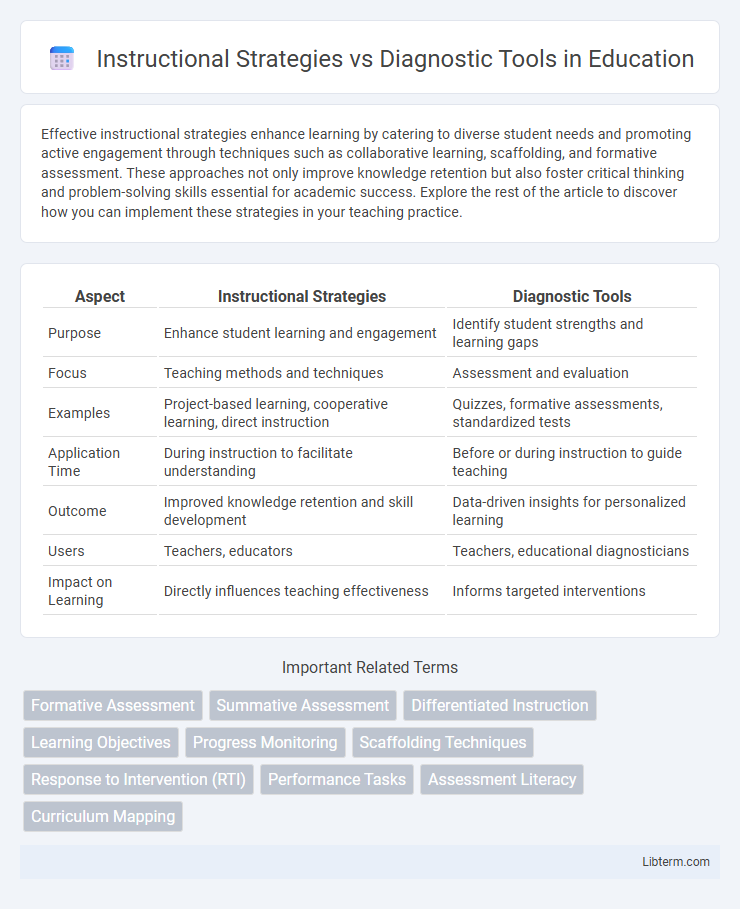Effective instructional strategies enhance learning by catering to diverse student needs and promoting active engagement through techniques such as collaborative learning, scaffolding, and formative assessment. These approaches not only improve knowledge retention but also foster critical thinking and problem-solving skills essential for academic success. Explore the rest of the article to discover how you can implement these strategies in your teaching practice.
Table of Comparison
| Aspect | Instructional Strategies | Diagnostic Tools |
|---|---|---|
| Purpose | Enhance student learning and engagement | Identify student strengths and learning gaps |
| Focus | Teaching methods and techniques | Assessment and evaluation |
| Examples | Project-based learning, cooperative learning, direct instruction | Quizzes, formative assessments, standardized tests |
| Application Time | During instruction to facilitate understanding | Before or during instruction to guide teaching |
| Outcome | Improved knowledge retention and skill development | Data-driven insights for personalized learning |
| Users | Teachers, educators | Teachers, educational diagnosticians |
| Impact on Learning | Directly influences teaching effectiveness | Informs targeted interventions |
Understanding Instructional Strategies
Instructional strategies encompass various teaching methods designed to facilitate student learning, such as direct instruction, cooperative learning, and differentiated instruction, aiming to address diverse learning styles and improve engagement. These strategies are informed by educational theories and data from diagnostic tools, which assess student knowledge, skills, and learning gaps to guide instructional planning. Understanding instructional strategies involves recognizing how tailored approaches can optimize content delivery and foster deeper comprehension across varied educational contexts.
Defining Diagnostic Tools in Education
Diagnostic tools in education are instruments and methods used to assess students' learning needs, strengths, and areas for improvement before instruction begins. These tools include pre-assessments, quizzes, and observation checklists designed to identify specific skill gaps and misconceptions. By providing detailed insights into students' current knowledge, diagnostic tools enable educators to tailor instructional strategies effectively for personalized learning outcomes.
Core Objectives: Instruction vs Assessment
Instructional strategies prioritize core objectives related to effective teaching methods and student engagement, aiming to facilitate learning through tailored approaches such as differentiated instruction and formative feedback. Diagnostic tools focus on assessment by identifying student knowledge gaps, skills proficiency, and learning needs through data-driven evaluations like pre-tests and skill inventories. The core objective of instruction is skill acquisition and concept mastery, while diagnostic tools serve assessment goals to inform targeted interventions and curriculum adjustments.
Key Differences Between Instructional Strategies and Diagnostic Tools
Instructional strategies focus on delivering content and facilitating learning through techniques such as differentiated instruction, cooperative learning, and scaffolding. Diagnostic tools primarily assess students' prior knowledge, learning gaps, and comprehension through formative assessments, quizzes, and diagnostic tests. The key difference lies in instructional strategies guiding teaching approaches, while diagnostic tools provide data-driven insights to tailor those strategies effectively.
Integrating Strategies with Diagnostic Tools
Integrating instructional strategies with diagnostic tools enhances personalized learning by identifying individual student needs and tailoring teaching methods accordingly. Utilizing data from diagnostic assessments allows educators to adapt instructional techniques in real-time, improving learning outcomes and addressing gaps effectively. This synergy between assessment and instruction fosters a responsive educational environment that supports continuous student growth and mastery.
Benefits of Effective Instructional Strategies
Effective instructional strategies enhance student engagement and comprehension by tailoring teaching methods to diverse learning styles and needs. They promote active learning, critical thinking, and long-term retention by encouraging collaboration, problem-solving, and formative assessment integration. These strategies ultimately improve academic performance and foster a supportive learning environment that motivates students and addresses individual strengths and weaknesses.
The Role of Diagnostic Tools in Personalized Learning
Diagnostic tools play a crucial role in personalized learning by identifying individual students' strengths, weaknesses, and learning gaps through data-driven assessments. These tools enable educators to tailor instructional strategies, adapt content delivery, and provide targeted interventions that enhance student engagement and academic achievement. Effectively integrating diagnostic tools promotes a responsive learning environment where instruction aligns with each learner's unique needs and pace.
Challenges in Balancing Instruction and Diagnosis
Balancing instructional strategies with diagnostic tools presents challenges such as allocating sufficient time for both teaching and ongoing assessment without compromising either. Educators often struggle to integrate real-time diagnostic data into instructional plans, leading to gaps in addressing individual student needs promptly. Effective solutions require seamless incorporation of diagnostic insights into instructional methods to enhance personalized learning while maintaining curriculum pacing.
Best Practices for Combining Both Approaches
Combining instructional strategies with diagnostic tools enhances personalized learning by using assessment data to tailor teaching methods that address individual student needs and learning gaps. Best practices include integrating formative assessments regularly to monitor progress and adjusting instructional techniques based on real-time diagnostic insights. Employing a data-driven approach ensures instructional strategies remain responsive and effective, fostering improved student outcomes through targeted support.
Future Trends in Educational Methods and Assessment
Emerging instructional strategies increasingly integrate artificial intelligence to provide personalized learning experiences, while diagnostic tools evolve with real-time data analytics to offer immediate feedback on student performance. Adaptive learning platforms combine cognitive science and machine learning to tailor content and assessments, enhancing both teaching effectiveness and precise identification of learning gaps. The convergence of virtual reality and immersive technologies further transforms future educational methods by enabling interactive diagnostics that engage diverse learning styles and improve outcome accuracy.
Instructional Strategies Infographic

 libterm.com
libterm.com